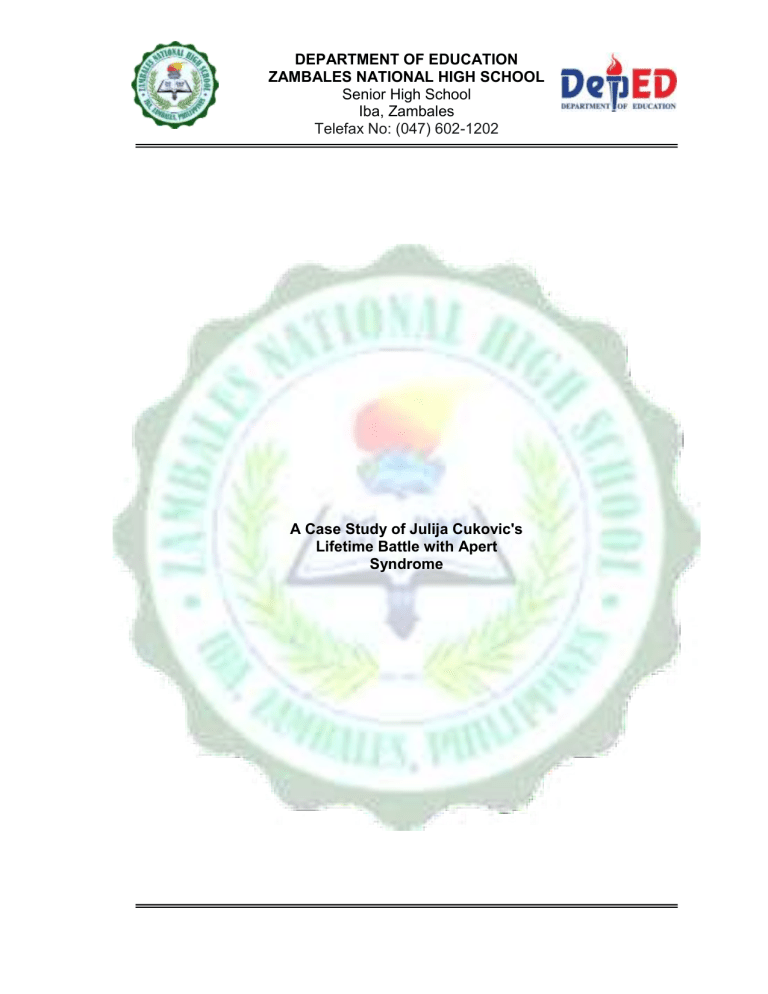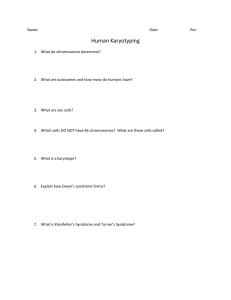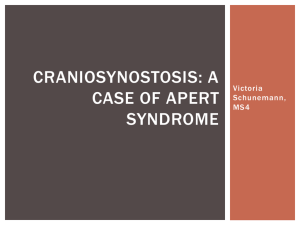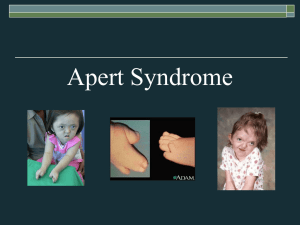
DEPARTMENT OF EDUCATION ZAMBALES NATIONAL HIGH SCHOOL Senior High School Iba, Zambales Telefax No: (047) 602-1202 A Case Study of Julija Cukovic's Lifetime Battle with Apert Syndrome DEPARTMENT OF EDUCATION ZAMBALES NATIONAL HIGH SCHOOL Senior High School Iba, Zambales Telefax No: (047) 602-1202 Synopsis Apert syndrome, also known as acrocephalosyndactyly, is a genetic disorder that causes the fusion of the skull, hands, and feet bones causing deformities. It occurs in one out of every 65,000 to 88,000 births. Julija Cukovic is an IVF baby, born in Serbia to proud parents Ivica and Jasmina Cukovic. She was diagnosed with Apert syndrome at birth. She already endured three surgeries before turning three years old. Back in the year 2015, three-year-old Julija has already had 30 specialist appointments. After several surgeries, she requires years of follow-up treatment and further surgery in her teenage years for her to have a normal life. Introduction Apert syndrome is defined as a rare genetic disorder that causes abnormal development of the skull discovered by French pediatrician Eugène Apert. Babies with this syndrome are born with a distorted shape of the head and face. They have fused skull bones when usually the bones join together over time. They have vision, hearing, breathing, and eating problems as well as slow development because they are born with a misshapen head. It has no cure, but surgery can help correct some of the problems that result (Hoffman,2022). According to Cleveland Clinic (2021), this syndrome is caused by the mutation of the FGFR2 gene that occurs early during pregnancy. The mutation could be inherited or newly formed. There is a 50% chance that you could have a child with Apert syndrome if one parent has a genetic condition (autosomal dominant). A child with Apert syndrome will require life-long observations and checkups. A doctor will check for additional complications caused by Apert syndrome and suggest appropriate treatments (Fletcher, 2018). Jasmina and Ivica Cukovic’s daughter, Julija Cukovic an IVF baby born in Serbia. She has been diagnosed with Apert Syndrome at the time of birth. She has undergone many surgeries and meets various specialist appointments to ensure she gets the very best treatment possible. This case study provides a detailed overview of Julija’s diagnosis, treatment, and progress in managing the symptoms of her condition as she goes through a lifetime fight with Apert syndrome. Additionally, it highlights the challenges faced by children with Apert syndrome and the needed interventions for effective treatment. Findings Apert syndrome is typically diagnosed at birth based on physical characteristics such as a high, prominent forehead, an underdeveloped upper jaw, prominent eyes, and fused fingers and toes. The degree of fusion in Apert syndrome varies; some people have three fused digits on each hand and foot, while others have more severe fusion or extra fingers/toes (polydactyly). Abnormalities in the elbow or shoulder bones can limit movement and impede daily activities in people with Apert syndrome. The syndrome is caused by a mutation in the FGFR2 gene, which hinders bone growth and development. Apert syndrome is inherited in an autosomal dominant pattern, and advanced paternal age is associated with an increased risk of the genetic mutation in sperm. Apert 2 DEPARTMENT OF EDUCATION ZAMBALES NATIONAL HIGH SCHOOL Senior High School Iba, Zambales Telefax No: (047) 602-1202 syndrome is treated primarily through surgeries. Julija Cukovic was born with Apert syndrome. She has vision, hearing, and breathing problems, as well as delayed development due to distorted skull bones. She also has webbed hands and feet and is unable to chew properly, making eating difficult. Julija's surgeries have been difficult due to her previous unsuccessful operation. Julija's case demonstrates the value of early diagnosis, specialized medical care, and a supportive home environment in managing and improving the quality of life for people with Apert syndrome. Discussion Apert syndrome is a genetic disorder characterized by skeletal abnormalities. A key feature of Apert syndrome is the premature closure of the bones of the skull known as craniosynostosis. This early fusion prevents the skull from growing normally and affects the shape of the head and face. In addition, a varied number of fingers and toes are fused called syndactyly. There are three main types of syndactyly in Apert syndrome: Type I (spade hand), Type II (mitten hand), and Type III (rosebud hand). The mutation occurs early in a pregnancy. Because FGFR2 plays an important role in bone growth, this gene provides instructions for making a protein; disruption of it may cause certain traits of Apert syndrome. Mutations in a gene known as FGFR2 cause Apert syndrome. Apert syndrome is inherited in an autosomal dominant pattern, which means one copy of the altered gene in each cell is sufficient to cause the disorder. Individuals with Apert syndrome have syndactyly of the fingers and toes. The severity of the fusion varies, although the hands tend to be more severely affected than the feet. Most commonly, three digits on each hand and foot are fused. In the most severe cases, all of the fingers and toes are fused. Rarely, people with Apert syndrome may have extra fingers or toes called "polydactyly". Some people with Apert syndrome have abnormalities in the bones of the elbows or shoulders. These bone problems can restrict movement and impede everyday activities. In some people, abnormalities occur on both sides of the body, but in others, only one side is affected. Apert syndrome is usually diagnosed at birth based on physical signs such as a high, prominent forehead, underdeveloped upper jaw, prominent eyes, and fused fingers and/or toes. Fused fingers and toes distinguish Apert syndrome from other craniofacial disorders. There is no known cure for Apert syndrome. Surgery will significantly reduce a child’s symptoms to help them lead a normal life. Surgery is done to release pressure to the brain, along with reconstructive surgery, will occur soon after your baby is born. Family history is usually not significant because most cases of Apert syndrome are sporadic. A paternal age effect increases in fathers older than 50 years. This means that the risk of having a child with Apert Syndrome is higher in older fathers than in younger fathers. The reason for this is that the genetic mutation that causes Apert Syndrome occurs more frequently in the sperm of older men. The risk of having a child with Apert Syndrome is 3 DEPARTMENT OF EDUCATION ZAMBALES NATIONAL HIGH SCHOOL Senior High School Iba, Zambales Telefax No: (047) 602-1202 estimated to be 9.5 times higher for fathers older than 50 years compared to those younger than 29 years. The increased frequency of mutations in sperm is thought to be due to the accumulation of mutations over time in the male germ cells. Apert syndrome has an autosomal dominant inheritance, and advanced paternal age is found to be associated with the de novo occurrence of Apert syndrome. There is a 50% chance of the genetic trait being passed to each child. If a pathologic variant person is present in the family, prenatal testing for pregnancies at increased risk should be ideally performed. Born in Kragujevac, a town 120km southeast of Belgrade, Julija Cukovic is in Adelaide to have life-changing surgery at the world-famous unit. After the baby was delivered, no one brought her to her mother, not even to be fed. Nobody, not even the doctors, explained. The couple asked about their daughter’s whereabouts and waited anxiously for an answer. Julija, it seemed, had been written off. It was assumed that not even her parents would want her around. She lives with Apert Syndrome, a rare genetic disorder that causes vision, hearing, and breathing problems as well as slow development as a result of being born with distorted skull bones. In Julija’s case, her fingers and toes have not separated either, which makes holding a crayon or picking things up difficult. When her parents finally learned about Julija’s disability, they were told that Julija would not live long and had best be placed in an institution. By the time she was barely older than three months, Juljia had undergone two surgeries on her head and had spent a month in intensive care with pneumonia. Because of her severe breathing problems and her need for frequent specialist attention, the Čukovićs decided with heavy hearts to place her in an institution for children with disabilities in the capital, where she would have quick access to emergency care. With hindsight, Jasmina realises that the decision to leave Juljia at the institution was not good for her child. True, the doctors and staff helped and supported herself and her husband, and Juljia received specialised medical care, but when she visited her baby only days after leaving her in the institution, “nothing had remained of that child who used to smile and coo,” she recalls. “She had a lost look in her eyes, had visibly lost weight and was sad in a way.” Shortly thereafter, Juljia had a bout of pneumonia and barely made it out of the hospital alive. Only now, with Juljia back at home with them, does Jasmina recall disturbing scenes she tried to downplay in her mind, like a little girl sitting in a chair alone all day without even a doll or a picture book to keep her occupied. Back home, surrounded by loving parents, toys, and a baby sister, Juljia is thriving. She has put on weight and has not only learned to sit, which she was unable to do when her parents brought her back from Zvečanska, but also to walk. Unlike so many children in institutions, she gets to wear her own favourite clothes. Conclusion Apert syndrome (acrocephalosyndactyly) is an autosomal dominant condition in which increased paternal age has been implicated in its development. It is a rare genetic disorder that causes craniosynostosis and syndactyly. While there is no cure for Apert syndrome, treatments and surgeries can help manage symptoms and improve quality of 4 DEPARTMENT OF EDUCATION ZAMBALES NATIONAL HIGH SCHOOL Senior High School Iba, Zambales Telefax No: (047) 602-1202 life. Treatment usually involves a multidisciplinary approach, including plastic surgeons, neurosurgeons, ophthalmologists, otolaryngologists, and orthopedic surgeons. The case of Julija Cukovic provides a thorough understanding of the difficulties encountered by people with this rare genetic disorder. Julija's journey demonstrates the value of early diagnosis, specialized medical care, and a supportive environment. Despite multiple surgeries and specialist appointments, Julija's progress demonstrates the effectiveness of surgical interventions in managing Apert syndrome symptoms. Moreover, her case emphasizes the importance of parental support and a nurturing home environment in promoting the well-being and development of people with Apert syndrome. Healthcare professionals and families can collaborate to improve the lives of those affected by this difficult genetic disorder by raising awareness and providing insights into their experiences, as Julija did. Recommendations Based on the information gathered from the case study and growing knowledge of Apert syndrome, here are some recommendations that aim to enhance the general care and welfare of those who have the condition: 1. Early Diagnosis and Intervention: To initiate the right interventions and treatments as soon as possible, Apert syndrome must be diagnosed as soon as possible. 2. Surgical Treatments: The treatment of Apert syndrome heavily relies on surgery. Relieving pressure on the brain, reconstructing damaged areas, and enhancing function are the main objectives of surgery. Depending on the specific needs of the patient, specialized surgical treatments like Craniofacial treatment and the separation of fused fingers and toes should be taken into consideration. 3. Multidisciplinary Care: Treatment for Apert syndrome requires a multidisciplinary approach. To provide comprehensive care tailored to each patient's needs, a multidisciplinary team comprising plastic surgeons, neurosurgeons, ophthalmologists, otolaryngologists, orthopedic surgeons, and therapists should collaborate. 4. Frequent Follow-up and Monitoring: To evaluate their progress, spot any issues or difficulties, and modify treatment regimens as necessary, people with Apert syndrome should have frequent follow-up appointments and monitoring. 5. Supportive Home Environment: For people with Apert syndrome, it's essential to establish a loving and encouraging home environment. In addition to giving opportunities for social and educational growth, parents and other caregivers should also offer emotional support and access to relevant resources. Providing assistive technology, like breathing machines and hearing aids, and promoting independence can also improve the person's quality of life. 6. Education and Awareness: It is crucial to educate the public, educators, and healthcare professionals about Apert syndrome. Providing the public with 5 DEPARTMENT OF EDUCATION ZAMBALES NATIONAL HIGH SCHOOL Senior High School Iba, Zambales Telefax No: (047) 602-1202 knowledge about the difficulties experienced by people with Apert syndrome can foster acceptance, tolerance, and support. References Cleveland Clinic. (2021, November 22). Apert Syndrome. https://my.clevelandclinic.org/health/diseases/22077-apertsyndrome?fbclid=IwAR19CJlg6PpRg03OrthmbSDgxDvrOb0_Zrsl6ECBg_IsrIR2 NHybpg9FgFU Fletcher, J. (2018, February 13). What is Apert syndrome? MedicalNewsToday. https://www.medicalnewstoday.com/articles/320907?fbclid=IwAR17Cj0T2tL2VIn5 7utmmgtzI-0JZAL-Kii42YtHYsDtAGZ1MvyGjbqklNQ Guo, G. W., MD. (2020, August 16). Apert Syndrome clinical presentation: history, physical, causes. Medscape. https://emedicine.medscape.com/article/941723clinical?fbclid=IwAR2Qwnw4Umb_K0Mc7svC6QcCBCBfaiCNjIKxcCGdGgU5AcSaf1Rp16jh14&form=fpf Hoffman, M., MD. (2022, December 06). Apert Syndrome. WebMD. https://www.webmd.com/children/apert-syndrome-symptoms-treatmentsprognosis?fbclid=IwAR1ysJEHyi8avHZpdFNF22UIYpGg2AuMM-J2g7PpAcKG0Z9zziHnn3-3yM MedlinePlus. (2019, August 1). Apert Syndrome. https://medlineplus.gov/genetics/condition/apertsyndrome/?fbclid=IwAR0NsXRDqH_PqHIZzNW_4qGkEwSN6ptXheCiZwekcozW 1g7FezUPLDxBPPo Schwarz, B. (2016, June 9). A parent’s most difficult choice: The awful truth about Serbia’s institutions for children. Heraldsun. https://www.heraldsun.com.au/lifestyle/aparents-most-difficult-choice-the-awful-truth-about-serbias-institutions-forchildren/newsstory/916dd732d1d5dd9b9494b9f93bf69cfb?fbclid=IwAR2CPNyjTbz168v7tE5qiK 4cuXTRO_bRQwh45RDtM-fy69i9khdRKdQviQc Stokes, K. (2015, February 2). Julija Cukovic, born with Apert Syndrome, to undergo lifechanging surgery at the Australian Craniofacial Unit. The Advertiser. https://www.adelaidenow.com.au/news/south-australia/julija-cukovic-born-withapert-syndrome-to-undergo-lifechanging-surgery-at-the-australian-craniofacialunit/newsstory/08cacafcfe472ac37b2e43658c6ab3f6?fbclid=IwAR0d9OTTBlM6KvTX_un6 62nY-FdtWr9AbT_ayDmQXIb9vF5FBS1821x6OaA 6


